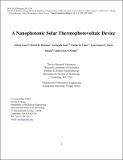A nanophotonic solar thermophotovoltaic device
Author(s)
Lenert, Andrej; Bierman, David Matthew; Soljacic, Marin; Wang, Evelyn; Celanovic, Ivan L.; Nam, Young Suk; Chan, Walker R; ... Show more Show less
DownloadWang_A nanophotonic plus supp.pdf (1.988Mb)
PUBLISHER_POLICY
Publisher Policy
Article is made available in accordance with the publisher's policy and may be subject to US copyright law. Please refer to the publisher's site for terms of use.
Terms of use
Metadata
Show full item recordAbstract
The most common approaches to generating power from sunlight are either photovoltaic, in which sunlight directly excites electron–hole pairs in a semiconductor, or solar–thermal, in which sunlight drives a mechanical heat engine. Photovoltaic power generation is intermittent and typically only exploits a portion of the solar spectrum efficiently, whereas the intrinsic irreversibilities of small heat engines make the solar–thermal approach best suited for utility-scale power plants. There is, therefore, an increasing need for hybrid technologies for solar power generation. By converting sunlight into thermal emission tuned to energies directly above the photovoltaic bandgap using a hot absorber–emitter, solar thermophotovoltaics promise to leverage the benefits of both approaches: high efficiency, by harnessing the entire solar spectrum; scalability and compactness, because of their solid-state nature; and dispatchablility, owing to the ability to store energy using thermal or chemical means. However, efficient collection of sunlight in the absorber and spectral control in the emitter are particularly challenging at high operating temperatures. This drawback has limited previous experimental demonstrations of this approach to conversion efficiencies around or below 1% (refs 9, 10, 11). Here, we report on a full solar thermophotovoltaic device, which, thanks to the nanophotonic properties of the absorber–emitter surface, reaches experimental efficiencies of 3.2%. The device integrates a multiwalled carbon nanotube absorber and a one-dimensional Si/SiO[subscript 2] photonic-crystal emitter on the same substrate, with the absorber–emitter areas optimized to tune the energy balance of the device. Our device is planar and compact and could become a viable option for high-performance solar thermophotovoltaic energy conversion.
Date issued
2014-01Department
Massachusetts Institute of Technology. Institute for Soldier Nanotechnologies; Massachusetts Institute of Technology. Department of Electrical Engineering and Computer Science; Massachusetts Institute of Technology. Department of Mechanical Engineering; Massachusetts Institute of Technology. Department of Physics; Massachusetts Institute of Technology. Research Laboratory of ElectronicsJournal
Nature Nanotechnology
Publisher
Nature Publishing Group
Citation
Lenert, Andrej, David M. Bierman, Youngsuk Nam, Walker R. Chan, Ivan Celanovic, Marin Soljacic, and Evelyn N. Wang. “A Nanophotonic Solar Thermophotovoltaic Device.” Nature Nanotechnology 9, no. 2 (January 19, 2014): 126–130.
Version: Author's final manuscript
ISSN
1748-3387
1748-3395